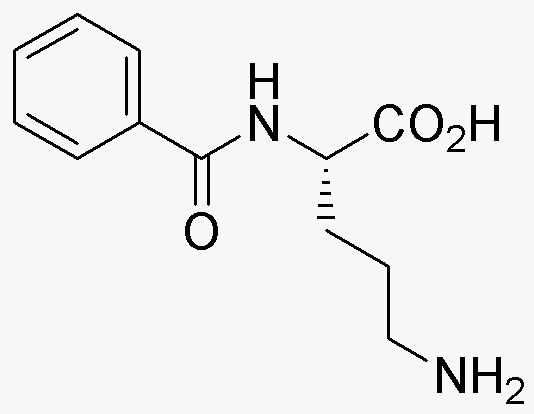Na-Benzoyl-L-ornithine is widely utilized in research focused on:
- Peptide Synthesis: This compound serves as a valuable building block in the synthesis of peptides, which are essential in drug development and biochemistry.
- Pharmaceutical Development: It plays a role in the formulation of pharmaceuticals, particularly in creating compounds that target specific biological pathways.
- Biochemical Research: Researchers use it to study protein interactions and enzyme activity, providing insights into various biological processes.
- Cosmetic Industry: Its properties are leveraged in the formulation of skincare products, where it can enhance skin penetration and efficacy of active ingredients.
- Diagnostic Applications: It is used in the development of diagnostic tools, particularly in assays that require specific binding interactions.
General Information
Properties
Safety and Regulations
Applications
Na-Benzoyl-L-ornithine is widely utilized in research focused on:
- Peptide Synthesis: This compound serves as a valuable building block in the synthesis of peptides, which are essential in drug development and biochemistry.
- Pharmaceutical Development: It plays a role in the formulation of pharmaceuticals, particularly in creating compounds that target specific biological pathways.
- Biochemical Research: Researchers use it to study protein interactions and enzyme activity, providing insights into various biological processes.
- Cosmetic Industry: Its properties are leveraged in the formulation of skincare products, where it can enhance skin penetration and efficacy of active ingredients.
- Diagnostic Applications: It is used in the development of diagnostic tools, particularly in assays that require specific binding interactions.
Documents
Safety Data Sheets (SDS)
The SDS provides comprehensive safety information on handling, storage, and disposal of the product.
Product Specification (PS)
The PS provides a comprehensive breakdown of the product’s properties, including chemical composition, physical state, purity, and storage requirements. It also details acceptable quality ranges and the product's intended applications.
Certificates of Analysis (COA)
Search for Certificates of Analysis (COA) by entering the products Lot Number. Lot and Batch Numbers can be found on a product’s label following the words ‘Lot’ or ‘Batch’.
*Catalog Number
*Lot Number
Certificates Of Origin (COO)
This COO confirms the country where the product was manufactured, and also details the materials and components used in it and whether it is derived from natural, synthetic, or other specific sources. This certificate may be required for customs, trade, and regulatory compliance.
*Catalog Number
*Lot Number
Safety Data Sheets (SDS)
The SDS provides comprehensive safety information on handling, storage, and disposal of the product.
DownloadProduct Specification (PS)
The PS provides a comprehensive breakdown of the product’s properties, including chemical composition, physical state, purity, and storage requirements. It also details acceptable quality ranges and the product's intended applications.
DownloadCertificates of Analysis (COA)
Search for Certificates of Analysis (COA) by entering the products Lot Number. Lot and Batch Numbers can be found on a product’s label following the words ‘Lot’ or ‘Batch’.
*Catalog Number
*Lot Number
Certificates Of Origin (COO)
This COO confirms the country where the product was manufactured, and also details the materials and components used in it and whether it is derived from natural, synthetic, or other specific sources. This certificate may be required for customs, trade, and regulatory compliance.


